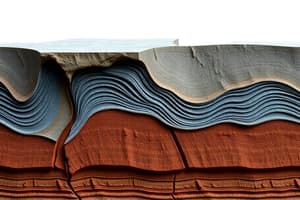Podcast
Questions and Answers
ما هي الحركة التي تحدث على طول الكسور في الانزلاق الجانبي؟
ما هي الحركة التي تحدث على طول الكسور في الانزلاق الجانبي؟
- حركة صعودية
- حركة أفقية (correct)
- حركة انحرافية
- حركة رأسية
ما هو نوع الكسر الذي يتميز بأن اللوحة العلوية تتحرك صعودًا بالنسبة للوحة السفلية؟
ما هو نوع الكسر الذي يتميز بأن اللوحة العلوية تتحرك صعودًا بالنسبة للوحة السفلية؟
- الكسور الانزلاقية
- الكسور المستقيمة
- الكسور العادية
- الكسور المعاكسة (correct)
ما هو النوع المنتشر للكسور التي تتسبب في زلازل بسبب تمدد سطح الأرض؟
ما هو النوع المنتشر للكسور التي تتسبب في زلازل بسبب تمدد سطح الأرض؟
- الكسور المتدحرجة
- الكسور المستقيمة (correct)
- الكسور المعاكسة
- الكسور الانزلاقية
ما هي الظاهرة المصاحبة للكسور التي تتمثل في تدوير الصخور على طول سطح الكسر؟
ما هي الظاهرة المصاحبة للكسور التي تتمثل في تدوير الصخور على طول سطح الكسر؟
أي من هذه الأنواع من الكسور يتميز بأن حجراته يتم تحريكها أفقيًا في اتجاهات معاكسة؟
أي من هذه الأنواع من الكسور يتميز بأن حجراته يتم تحريكها أفقيًا في اتجاهات معاكسة؟
ما الذي يتم وصفه بالميكانيزم المركزي؟
ما الذي يتم وصفه بالميكانيزم المركزي؟
ما هو تأثير وجود Fault Scarp بعد وقوع زلزال؟
ما هو تأثير وجود Fault Scarp بعد وقوع زلزال؟
ما هي أهمية حدوث Aftershocks بعد زلزال رئيسي؟
ما هي أهمية حدوث Aftershocks بعد زلزال رئيسي؟
ما هي ميزة Seismic Zones؟
ما هي ميزة Seismic Zones؟
ما هو الناتج المباشر لحركة Fault Blocks نتيجة لوجود عيب؟
ما هو الناتج المباشر لحركة Fault Blocks نتيجة لوجود عيب؟
Flashcards are hidden until you start studying
Study Notes
Understanding Faults and Their Companions in Earth's Crust
Earth's crust is a dynamic entity, constantly reshaping itself in response to forces deep within and beneath its surface. Among the pivotal features influencing this change are faults and the phenomena they bring to our planet's geological landscape.
Faults
Faults are fractures or breaks in the Earth's crust where movement has occurred along the fracture surface. They are created when tectonic plates collide, slide past one another, or separate, leading to the displacement of rock units relative to their initial position. Faults are classified as strike-slip, normal, or reverse faults, depending on the type of movement along the fracture.
Strike-Slip Faults
Strike-slip faults occur when rocks on either side of the fault move horizontally in opposite directions. They produce earthquakes due to their shearing motion. The famous San Andreas Fault in California is a notable example of a strike-slip fault.
Normal Faults
Normal faults develop when the upper plate is displaced downward relative to the lower plate. This movement results in the formation of a dip-slip fault. Earthquakes caused by normal faults are often associated with the stretching of the Earth's surface, as seen in the Basin and Range region of the United States.
Reverse Faults
Reverse faults occur when the upper plate moves upward relative to the lower plate. They form when two tectonic plates collide and one is forced beneath the other in a process known as subduction. The Himalayas and Rocky Mountains are examples of mountain ranges formed by reverse faulting.
Earthquakes
Earthquakes are a direct consequence of fault movement. They occur when the accumulated stress along a fault reaches a critical threshold, causing the rocks to fracture. The motion during an earthquake is usually quite brief, lasting only a few seconds to minutes.
Seismic Waves
When an earthquake occurs, seismic waves are generated and travel through the Earth's crust. These waves come in two main types: P-waves (primary waves) and S-waves (secondary waves). P-waves are faster and originate from compression and expansion in the rock, while S-waves originate from shearing motion and travel slower.
Focal Mechanism
The focal mechanism describes the type of fault movement during an earthquake. This mechanism is commonly displayed on a seismogram as a double-couple, which demonstrates the relative motion between the two plates, including the orientation and direction of slip.
Aftershocks
After a main earthquake, smaller aftershocks may occur. Aftershocks are the result of the stress redistribution within the fault zone following the main event.
Phenomena Associated with Faults
In addition to the direct effects of fault movement and earthquakes, there are several other phenomena related to faults that impact the surface and subsurface environments.
-
Seismic Zones: These are regions where faults are active and seismic activity occurs.
-
Fault Scarp: The steep slope of rock left after a fault has displaced the Earth's surface.
-
Fault Blocks: Blocks of rock displaced by faults.
-
Tectonic Valley: A valley formed by the downwarping of the Earth's crust due to fault activity.
-
Tectonic Mountain: A mountain range formed by the uplift of the Earth's surface due to fault activity.
-
Tectonic Basin: A basin formed by the subsidence of the Earth's crust due to fault activity.
In summary, faults and the phenomena associated with them serve as critical components in shaping our planet's landscape and influencing our understanding of the Earth's dynamic systems. As our scientific knowledge expands, so too does our ability to predict and mitigate the effects of faults, earthquakes, and other associated phenomena.
Studying That Suits You
Use AI to generate personalized quizzes and flashcards to suit your learning preferences.



